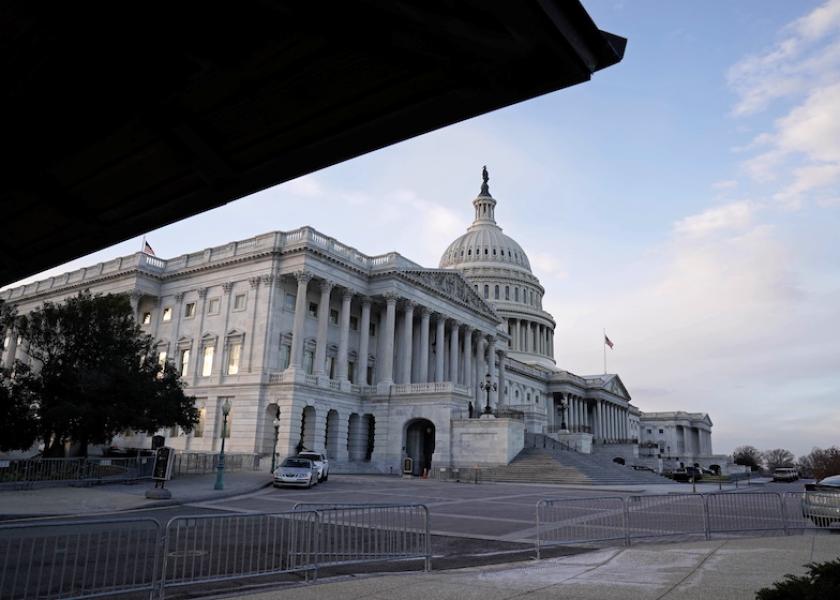Covid Aid Bill Provides Ag Funding for Sectors Left Out of CFAP

By John Herath and Jim Wiesemeyer
The coronavirus aid package approved by Congress overnight Monday provides $13 billion in ag funding, much of it destined for sectors left out of previous aid packages.
The bill gives the USDA Secretary the authority to make payments to livestock producers who had to depopulate their herds due to limited processing plant capacity because of COVID-19 outbreaks. It also provides for assistance long sought by biofuel producers.
“Today’s passage of this landmark legislation is great news for America’s ethanol producers, who have struggled through the most difficult and trying year in the industry’s history,” said Renewable Fuels Association President and CEO Geoff Cooper. “More than half of the ethanol industry shut down during the extraordinary demand collapse in the spring, and producers across the country still have not fully recovered from that market shock. The pandemic has cost the industry nearly $4 billion in lost revenue to date, with losses expected to continue well into 2021. The legislation passed today provides a ray of hope for the industry and provides decisive direction to the Secretary regarding the eligibility of renewable fuel producers to receive assistance from USDA.”
The biofuel payments are left largely at the discretion of the USDA Secretary.
The American Farm Bureau Federation (AFBF) praised the bill for adding support for portions of agriculture left out of previous aid packages.
“We’re pleased that Congress understands the toll the pandemic continues to take on farmers, ranchers and rural Americans,” said AFBF President Zippy Duvall. “Farmers who were left out of previous aid packages or whose losses were far more devastating than recognized in initial aid are grateful that their families will be helped, too. We recognize the need is great across our entire economy and farm families will join the rest of America in our determination to recover from the hardships caused by the COVID-19 pandemic.”
A summary of the ag provisions of the bill from Pro Farmer’s Jim Wiesemeyer:
AGRICULTURE ASSISTANCE ($13 billion)
Provides $11.1875 billion for COVID-related assistance to support agricultural producers, growers, processors, specialty crops, non-specialty crops, dairy, livestock, poultry, and contract livestock and poultry producers and other purposes.
- Provides supplemental assistance to price trigger crops and flat rate crops of $20 per acre.
- Addresses unintended inequities in the USDA’s sales commodity program for specialty crop and other producers who suffered a disaster in 2019. • Directs the Secretary to make payments to producers for losses incurred due to the depopulation of livestock and poultry due to insufficient processing access.
- Provides support for cattle producers.
- Provides $1 billion for contract growers of livestock and poultry to cover losses.
- Provides $20 million for animal disease prevention and response capacity. • Assists domestic users of upland cotton and extra-long staple cotton and allows for support to processors for losses of crops due to insufficient processing access.
- Extends the term of marketing assistance loans for any loan commodity to 12 months.
- Provides $1.5 billion for the Secretary to purchase food and agriculture products, including seafood, and to purchase and distribute agriculture products including fresh dairy, produce and meat products through NGOs, and provides for grants and loans to small or midsized food processors or distributors, seafood processing facilities and processing vessels, farmers markets, producers, or other organizations to respond to COVID-19 and protect workers.
- • Allows for $200 million in payments to timber harvesting and hauling. • Allows for payments to producers of advanced biofuel, biomass-based diesel, cellulosic biofuel, conventional biofuel, or renewable fuel.
- • Allows USDA to carry out a dairy recourse loan program to make purchases of dairy products from processors, packagers, merchants, marketers, wholesalers, and distributors. Other assistance includes:
- $100 million for Specialty Crop Block Grants, $100 million for Local Agriculture Marketing Program, $75 million for the Gus Schumacher Nutrition Assistance Program, and $75 million for Farming Opportunities Training and Outreach (FOTO).
- $28 million in grants to State Departments of Agriculture to expand or sustain stress assistance programs for individuals engaged in farming, ranching, and other agriculture operations.
- $200 million for nutrition research.
- Provides supplemental Dairy Margin Coverage support. Includes $400 million to support dairy donations to non-profit entities (food banks, feeding programs, etc.).
- Establishes a livestock dealer trust to benefit unpaid sellers of livestock.
- Assists meat and poultry slaughtering and processing facilities with making improvements to allow for interstate shipment. Requires a study on programs for meat and poultry processing and slaughtering facilities.







